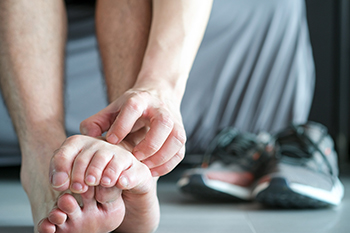
Athlete’s foot is a fungal infection that affects the skin on the feet, especially between the toes. It thrives in warm and moist environments, making locker rooms and damp socks ideal breeding grounds. Symptoms include itching, burning, peeling, and sometimes a red, scaly rash. In some cases, it may cause blisters or cracking skin. However, athlete's foot can resemble other skin issues like eczema or psoriasis, so proper diagnosis is essential. Antifungal creams and powders can be effective treatments for mild cases. For stubborn cases, prescription medication may be needed. To prevent athlete’s foot, keep feet dry and clean, avoid sharing footwear, and always wear flip-flops in communal showers and other damp areas. Opt for moisture-wicking socks and breathable shoes to reduce sweat buildup. If you have a stubborn case of athlete’s foot, it is suggested that you seek a proper diagnosis and treatment from a chiropodist.
Athlete’s foot can be uncomfortable and unsightly. To learn more about preventing and treating this condition, please consult with one of the chiropodists from Complete Family Footcare & Therapy. Our clinicians will assess your condition and provide you with quality foot and ankle treatment.
What Is Athlete’s Foot?
Athlete’s foot refers to an infection of the skin on the feet that is caused by a fungus. This fungus is contagious and thrives in warm and moist environments. It is often spread in common areas such as public pools, locker rooms, and showers. It can also spread when sharing personal items, like shoes or towels, with an infected person.
Symptoms
The symptoms of athlete’s foot may include:
Itching, stinging, or burning of the skin on the feet
Cracking or peeling skin, especially between the toes and on the soles of the feet
Scaly, red rash on the foot
Blisters
Foul odor
Treatment
Treatment for athlete’s foot typically involves using over-the-counter topical antifungal medications on the feet. When over-the-counter options are ineffective, you may need to take prescription oral medications or topical antifungal drugs, or a combination of both.
Prevention
Preventing athlete’s foot places an emphasis on good foot hygiene practices.
You can prevent athlete’s foot by:
Washing and drying your feet thoroughly every day
Wearing shoes when walking in public areas
Not sharing personal items, like shoes or socks, with others
Wearing shoes and socks made out of breathable materials
If you have any questions, please feel free to contact our offices located in . We offer the newest diagnostic and treatment technologies for all your foot care needs.
